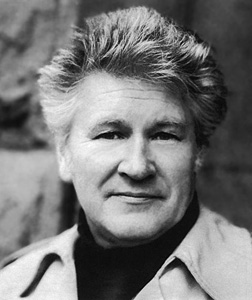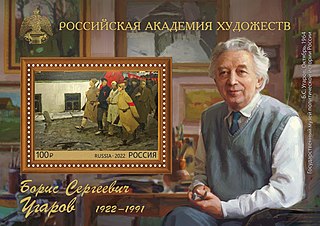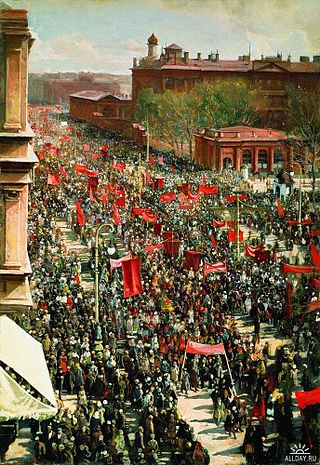
Pavlovsk is a municipal town in Pushkinsky District in the suburban part of the federal city of St. Petersburg, Russia, located 30 kilometers (19 mi) south from St. Petersburg proper and about 4 kilometers (2.5 mi) southeast from Pushkin. Population: 16,087 (2010 Census). Known since the late 18th century, when Saint Petersburg was the capital of Russian Empire, as a countryside residence of Russian royal family commissioned creation of the town's landmark -palace with a large park, now parts of its federal museum reserve.

Mikhail Alexandrovich Kaneev was a Soviet Russian painter and art teacher, lived and worked in Leningrad, a member of the Leningrad Union of Artists, regarded as a known representative of the Leningrad school of painting, most famous for his cityscapes of Leningrad and ancient Russian towns.

Veniamin Ivanovich Borisov was a Soviet Russian painter, a member of the Saint Petersburg Union of Artists (before 1992 – the Leningrad branch of Union of Artists of Russian Federation, lived and worked in Saint Petersburg, regarded as one of the representatives of the Leningrad school of painting.

Abram Borisovich Grushko was a Soviet painter and art teacher that lived and worked in Leningrad. He was a member of the Leningrad branch of Union of Artists of Russian Federation and was one of the representatives of the Leningrad school of painting. He was most famous for his many landscape paintings.

Yuri Nilovich Tulin was a Soviet Russian painter and Honored Artist of the Russian Federation. He lived and worked in Leningrad and is regarded as one of the brightest representatives of the Leningrad school of painting, most famous for his portraits and historical paintings.

Piotr Fedorovich Nazarov was a Soviet and Russian painter and art teacher, who lived and worked in Leningrad city, and who is regarded as one of representatives of the Leningrad school of painting.

Yuri Mikhailovich Neprintsev was a Soviet and Russian painter, graphic artist, art teacher, professor of the Repin Institute of Arts, and a member of the Academy of Arts of the USSR. He is regarded by art historian Sergei V. Ivanov as one of the brightest representatives of the Leningrad School of Painting, most famous for his genre and battle paintings.

Lev Nikolaevich Orekhov was a Russian Soviet painter, who lived and worked in Leningrad. He was regarded as one of the representatives of the Leningrad school of painting.
Oleg Leonidovich Lomakin was a Russian Soviet realist painter, Honored Artist of the RSFSR, who lived and worked in Saint Petersburg. He was regarded as one of the major representatives of the Leningrad school of painting.

Vladimir Fedorovich Chekalov was a Russian Soviet realist painter and art teacher, who lived and worked in Leningrad. He was a member of the Leningrad Union of Artists, and regarded as a representative of the Leningrad school of painting, most famous for his battle and genre paintings.
Rostislav Ivanovich Vovkushevsky was a Russian Soviet realist painter, who lived and worked in Leningrad. He was a member of the Saint Petersburg Union of Artists, and regarded as one of representatives of the Leningrad school of painting.

Nina Leonidovna Veselova was a Russian Soviet realist painter and graphic artist, Doctor of art-criticism (1954), who lived and worked in Leningrad. She was a member of the Leningrad Union of Artists and regarded as one of the brightest representatives of the Leningrad school of painting.

Valery Vladimirovich Vatenin was a Russian Soviet realist painter, graphic artist, and art teacher, who lived and worked in Leningrad. He was a member of the Leningrad branch of Union of Artists of Russian Federation, and regarded as one of the brightest representatives of the "left wing" of the Leningrad school of painting.

Yuri Dmitrievich Khukhrov was a Russian Soviet realist painter, graphic artist, and art teacher, who lived and worked in Saint Petersburg. He was a member of the Saint Petersburg Union of Artists, and regarded by art historian Sergei V. Ivanov as one of representatives of the Leningrad school of painting.

Boris Sergeevich Ugarov was a Russian Soviet realist painter and art educator, Honored Artist of the RSFSR, who lived and worked in Leningrad. He was a member of the Leningrad Union of Artists regarded as one of the brightest representatives of the Leningrad school of painting.

Emíl Wíesel – a painter, museum curator and a board member of the Imperial Academy of Arts, Russia, organizer of international art exhibitions, councilor of Hermitage and Russian museum and Legion of Honor holder. During soviet times he was an expert in Russian and Western fine arts and sculpture in the Glavnauka museum department.

The Leningrad School of Painting is a phenomenon that refers to a large group of painters who developed in Leningrad around the reformed Academy of Arts in 1930–1950 and was united by the Leningrad Union of Soviet Artists (1932–1991).
Boris Alexandrovich Fogel was a Russian Empire and Soviet painter and art educator who lived and worked in Leningrad, a member of the Leningrad Union of the Soviet Artists, and a professor of painting at the Repin Institute of Arts who played an important role in the formation of the Leningrad School of Painting.
Vladislav Leopoldovich Anisovich was a Russian and Soviet painter and art educator, who lived and worked in Leningrad, a member of the Leningrad Union of Soviet Artists, professor of the Repin Institute of Arts, regarded as one of representatives of the Leningrad School of Painting. Mostly known for his portrait paintings.

The fine art of Leningrad is an important component of Russian Soviet art—in the opinion of the art historians Vladimir Gusev and Vladimir Leniashin, "one of its most powerful currents". This widely used term embraces the creative lives and the achievements of several generations of Leningrad painters, sculptors, graphic artists and creators of decorative and applied art from 1917 to the early 1990s.





















